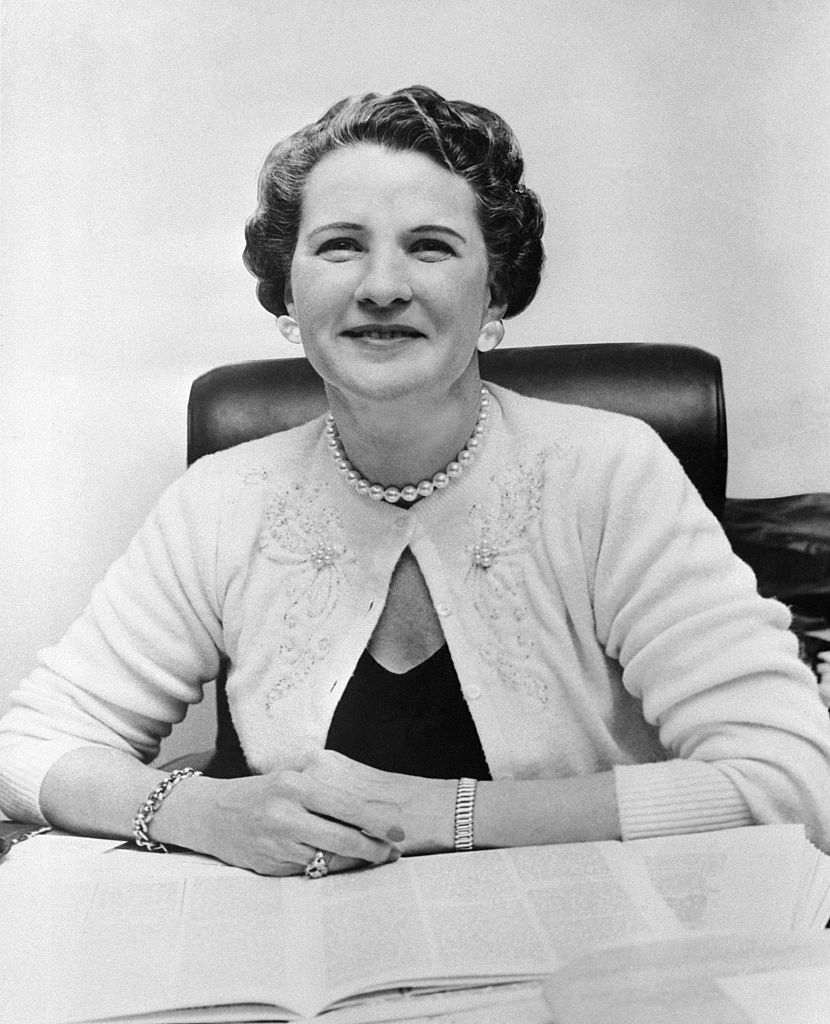Rep. Leonor Sullivan (D-Mo.) was one of only 11 women in the House in 1953. Aided by growing urban, Democratic power in the House, her efforts laid the groundwork for SNAP.

The Supplemental Nutrition Assistance Program (SNAP), formerly known as food stamps, is the nation’s most important food assistance programs for low-income Americans, and one of its most important anti-poverty measures. Before the COVID-19 pandemic, SNAP supplemented the food purchasing power of some 40 million Americans, at a cost of about $60 billion a year. Demand for SNAP, and program spending, ballooned with the pandemic’s economic dislocations, and the program played a key role in keeping rates of food insecurity and poverty from worsening.
SNAP’s centrality to the nation’s social welfare safety net is unintentional. In fact, the original food stamp program piloted during the Great Depression was designed to enable low-income households to “purchase” surplus agricultural commodities that otherwise might have gone to waste, which in turn provided needed income to food retailers, processors and farmers. Farm surpluses dried up with the onset of World War II, and the food stamp program was discontinued.
Leonor Sullivan had the honor of sponsoring the [Food Stamp Act of 1964] in the House, and fiercely defended the program against conservative opposition through the remainder of her House career.
But some in Congress saw food stamps as an effective way to get food to those in need and fought to revive the program. Chief among them was former Representative Leonor Sullivan (D-Mo.). Sullivan was first elected to the House in 1952 from a district previously represented by her late husband, not an atypical route to Congress for women in those days. This was after she won against six male candidates in a democratic primary and overcame the local party’s opposition to a woman candidate. She was one of only 11 women in the House in 1953; there were only 18 when she retired in 1977, as compared to 150 today.
Sullivan came to Congress determined to help her constituents, many of them low-income Black Americans who had come up the Mississippi during the Great Migration and saw food stamps as an efficient and more socially acceptable way to address hunger in her district. Efforts to bring back food stamps were opposed by rural conservatives who wanted nothing to do with “welfare,” and by the Eisenhower administration, which preferred to distribute surplus foods through local relief agencies. But Sullivan proved persistent and adept, using House rules to achieve her goals.
The excerpts below, from my book on the politics and history of SNAP, detail Sullivan’s legislative strategy, aided by growing urban, democratic power in the House, which eventually led Congress to approve food stamp “pilot projects.” New president John Kennedy would put the food stamp program into effect, and its success led Kennedy to propose what became the Food Stamp Act of 1964. Sullivan had the honor of sponsoring the bill in the House, and fiercely defended the program against conservative opposition through the remainder of her House career.

Of note, while Sullivan co-sponsored federal legislation to ensure equal pay for women, she was the only woman in Congress to vote against ratification of the Equal Rights Amendment.
In the House, efforts to establish some form of food stamps increasingly were driven by urban democrats like Rep. Sullivan, who, upon entering Congress in 1953, submitted the first of a series of bills authorizing a stamp program and soon became known for her relentless focus on food assistance.
As Sullivan later explained, “I became deeply concerned by the accounts of undernourishment among needy schoolchildren and others in St. Louis at about the same time the main concern on agricultural matters here in Washington seemed to be the unmanageable surpluses of food. The more I thought about this contradiction the more indignant I became.”
—Bosso, p. 56
Another point of potential leverage came during negotiations between the House and Senate over the Agricultural Act of 1956, the latest renewal of the “farm bill” that authorized commodity programs. The persistent Sullivan took advantage of acute intercrop and inter-chamber divisions on commodity programs as an opportunity to bypass an intransigent House Committee on Agriculture and persuade sympathetic conference committee negotiators to add language authorizing the USDA to run a food stamp program.
The compromise bill passed both chambers with the help of votes by urban democrats, who supported food stamps, only to be vetoed by Eisenhower over a number of disagreements, one of them over Sullivan’s amendment. The House, split along crop-specific policy differences as well as party lines, sustained Eisenhower’s veto. Congress then passed a revision, which Eisenhower signed, directing the USDA to analyze the feasibility of a food stamp program. The department did as mandated, with apparent reluctance.
While the staff experts who wrote the January 1957 report acknowledged the potential of food stamps to improve nutrition and even suggested ways to improve on the original plan (notably, by simplifying the two-stamp structure), USDA leaders nonetheless advised against a new stamp program on grounds of potentially high costs and modest impacts on surplus reduction.
Sullivan was unimpressed by their logic, given the millions being spent to purchase and store surplus commodities: “I am sorry the Department of Agriculture has resisted so strongly, so continuously, so cruelly, the idea of channeling some for the mountain of surplus commodities to these really poor Americans. True, there is in existence a surplus food-distribution program, but to characterize that program in a word, I would say it is wretched.”
—p. 58-59
In 1959 Rep. Sullivan inserted language into yet another renewal of PL 480 [which funded U.S. international food aid], directing the USDA to run food stamp “demonstration” projects. This tactic had been unsuccessful two years earlier, but the legislative landscape had changed with the 1958 midterm elections, which saw democrats increase their control of the House by 48 seats and the Senate by 13, their largest majorities since 1940.
Democrats made their greatest gains in eastern and midwestern cities, in the process shifting the congressional party’s balance of power away from its long-dominant rural southern wing. The impacts were evident during House floor consideration of Sullivan’s amendment. While rural Democrats still regarded food stamps as “welfare,” they also supported PL 480 foreign food aid as a “farmers program” and recognized that their urban colleagues now had the votes to block reauthorization if Sullivan’s amendment was left out. Sullivan made clear the strategy:
“Standing by itself, my bill might be vetoed. The Republican members of the Committee on Agriculture solidly opposed it, every one. Mr. Benson says he does not want it. He already has the authority to institute a food stamp plan such as called for in this amendment, but he won’t initiate it on his own authority. He has told Congress … that if the Congress wants him to run a food stamp program, it must enact legislation for such a program. Placing such legislation on this bill is the best way to comply with that demand, and establish a more readily intelligent system of distributing surplus food to our needy.”
Democratic leaders were eager to avoid an intraparty fight heading into the 1960 elections. Former House Speaker Sam Rayburn (D-Texas) apparently asked Rep. Sullivan what she wanted, “and I told him.” After no small amount of maneuvering, the sides agreed on a compromise: Largely along party lines, and with many Southern Democrats abstaining, the House in late August 1959 passed an amendment authorizing, but not requiring, the USDA to run food stamp “demonstration” projects and up to $250 million per year over two years to fund them. The Senate approved the amendment soon after, also largely along party lines.
—p. 62-63
Excerpts from Why SNAP Works: A Political History—and Defense—of the Food Stamp Program by Christopher John Bosso, published by the University of California Press. © 2023
Up next:
U.S. democracy is at a dangerous inflection point—from the demise of abortion rights, to a lack of pay equity and parental leave, to skyrocketing maternal mortality, and attacks on trans health. Left unchecked, these crises will lead to wider gaps in political participation and representation. For 50 years, Ms. has been forging feminist journalism—reporting, rebelling and truth-telling from the front-lines, championing the Equal Rights Amendment, and centering the stories of those most impacted. With all that’s at stake for equality, we are redoubling our commitment for the next 50 years. In turn, we need your help, Support Ms. today with a donation—any amount that is meaningful to you. For as little as $5 each month, you’ll receive the print magazine along with our e-newsletters, action alerts, and invitations to Ms. Studios events and podcasts. We are grateful for your loyalty and ferocity.





